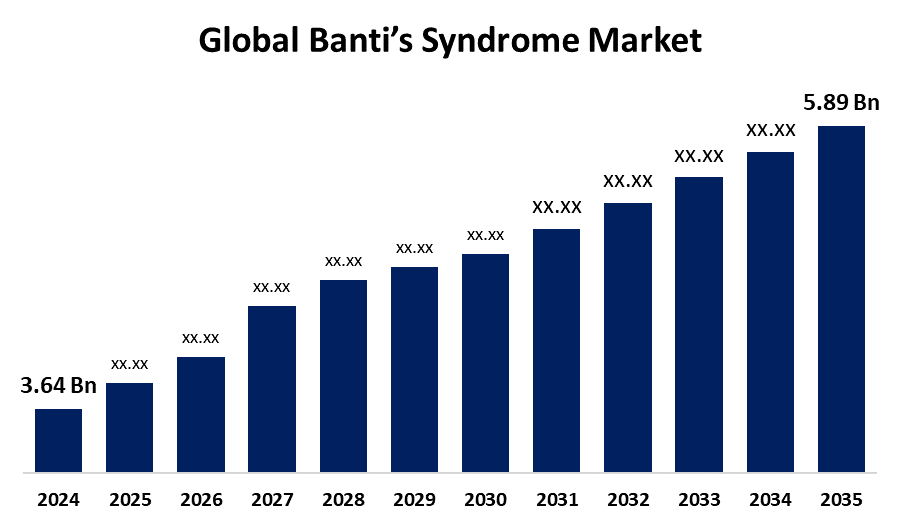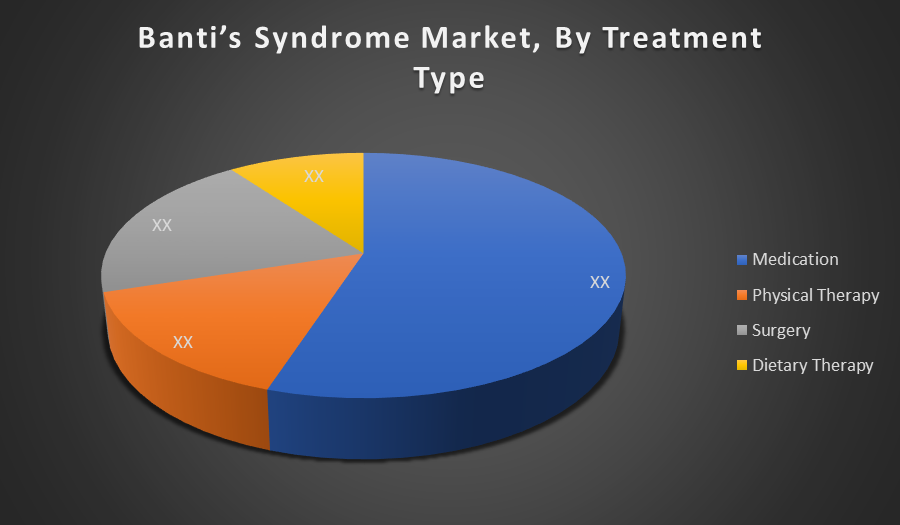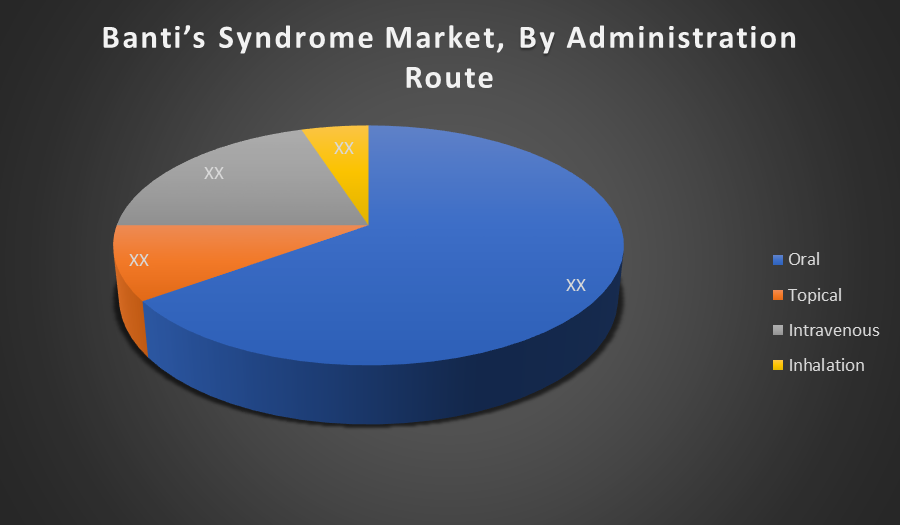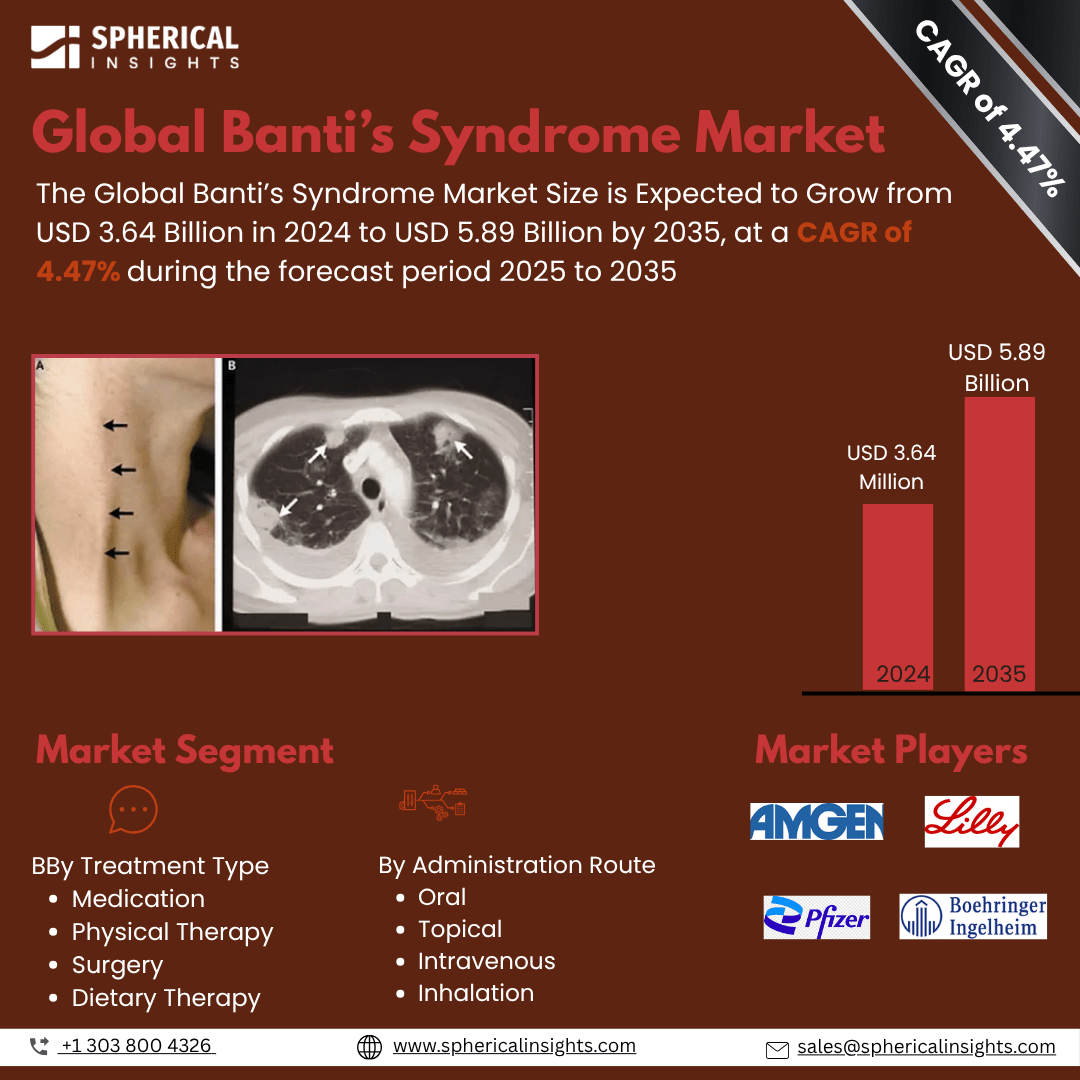- As per Spherical Insights & Consulting, The Global Banti’s Syndrome Market Size is Expected to Grow from USD 3.64 Billion in 2024 to USD 5.89 Billion by 2035, at a CAGR of 4.47% during the forecast period 2025 to 2035, owing to the launch of new therapies in the market and the rise in the number of cases.
- The leading Banti’s Syndrome Market Companies such as Takeda, AbbVie, Bayer, Johnson & Johnson, AstraZeneca, Amgen, Boehringer Ingelheim, Eli Lilly, Pfizer, Novartis, Teva Pharmaceuticals, Merck & Co., Sanofi, GlaxoSmithKline, Bristol-Myers Squibb, and Others.
Banti’s Syndrome Treatment Market: Understanding and Treatment Algorithm:
Banti’s Syndrome is a rare, non-cirrhotic condition characterized by chronic congestion of the spleen due to obstruction in the portal venous system. It leads to splenomegaly, hypersplenism, and anemia. Patients often experience fatigue, recurrent infections, and bleeding tendencies, as the condition affects blood cell counts and liver circulation.

Banti’s Syndrome Diagnosis:
Diagnosis of Banti’s Syndrome involves clinical evaluation, blood tests showing pancytopenia, and imaging studies such as Doppler ultrasound or CT scan to assess portal hypertension and splenomegaly. Liver biopsy may be done to rule out cirrhosis. The condition is often diagnosed by exclusion after eliminating other hepatic and hematologic disorders.
Banti’s Syndrome Treatment:
Treatment for Banti’s Syndrome focuses on symptom control and managing complications. Beta-blockers are used to reduce portal hypertension, while diuretics help with fluid overload. In severe cases, splenectomy may be considered. Supportive therapies include blood transfusions and antibiotics to manage infections due to hypersplenism and low white cell counts.
Banti’s Syndrome Epidemiology:
The disease epidemiology covered in the report provides historical as well as forecasted epidemiology segmented by Total Diagnosed Incident Population of Banti’s Syndrome, Gender specific Diagnosed Incidence of Banti’s Syndrome, Type specific Diagnosed Incidence of Banti’s Syndrome, Age specific Diagnosed Incidence of Banti’s Syndrome, Diagnosed Incident Population based on Primary Site of Banti’s Syndrome, and Diagnosed Incident Population based on Histologic Classification of Banti’s Syndrome Tumour in the global market covering North America, Europe, Asia-Pacific, Latin America, the Middle East, and Africa from 2024 to 2035.
Principal Insights:
This section offers a global overview of Banti’s Syndrome epidemiology in major markets worldwide.
Country Wise Banti’s Syndrome Multiforme Epidemiology:
- The epidemiology segment provides Banti’s Syndrome prevalence data and findings across key regions worldwide, including North America, Europe (Germany, France, Italy, Spain, and the United Kingdom), Asia-Pacific (including Japan), Latin America, the Middle East, and Africa.
Banti’s Syndrome Marketed Drugs:
• Propranolol: AstraZeneca
Propranolol is a non-selective beta-blocker used to manage portal hypertension, a key complication of Banti’s Syndrome. It reduces blood pressure in the portal vein, lowering the risk of variceal bleeding. Though not specific to Banti’s Syndrome, it is widely prescribed for symptom control in non-cirrhotic portal hypertension patients.
• Furosemide: Sanofi
Furosemide is a loop diuretic commonly used to manage fluid retention and reduce splenomegaly-related discomfort in patients with Banti’s Syndrome. It helps alleviate symptoms associated with portal hypertension by promoting diuresis. Although not curative, it is part of the supportive care regimen to manage complications arising from this vascular condition.
Banti’s Syndrome: Emerging Therapies:
- BXN-201: It is an experimental anti-inflammatory agent currently in early-stage development for Banti’s Syndrome. It aims to reduce vascular congestion and portal hypertension by targeting inflammatory mediators involved in splenic and hepatic blood flow. This therapy shows promise in managing underlying vascular dysfunction and is being evaluated for its ability to slow disease progression.
- FGM-134: It is an investigational antifibrotic agent designed to treat Banti’s Syndrome by targeting early-stage fibrotic changes in the spleen and portal venous system. It modulates fibrogenic signaling pathways to prevent disease progression and reduce complications like hypersplenism and anemia. Currently in preclinical trials, it shows potential in managing non-cirrhotic portal hypertension.
Banti’s Syndrome Market Outlook:
- Banti’s Syndrome Market refers to the healthcare segment focused on diagnosing and managing a rare chronic condition characterized by non-cirrhotic portal hypertension. It includes pharmaceutical treatments, surgical interventions, and supportive therapies aimed at controlling complications such as splenomegaly, anemia, and gastrointestinal bleeding caused by the syndrome.
- Key market drivers include increasing awareness of rare diseases, advances in diagnostic imaging and blood analysis, and availability of effective medications to manage symptoms. Rising healthcare access in developing countries and support from rare disease research foundations also contribute to the growing demand for Banti’s Syndrome management solutions.
- Opportunities exist in developing targeted therapies, expanding rare disease registries, and investing in early diagnostic tools. Pharmaceutical firms are exploring orphan drug development, while collaborations between hospitals and research institutions aim to improve clinical outcomes. These advances may drive long-term innovation in Banti’s Syndrome treatment pathways.
- Governments are promoting rare disease awareness through funding programs, orphan drug legislation, and early screening initiatives. Policies supporting accelerated approvals and research grants for underserved conditions like Banti’s Syndrome help drive therapeutic development and improve patient access to advanced diagnostic and treatment services.
- Limited clinical awareness and delayed diagnosis due to symptom overlap with other hepatic disorders hinder effective management of Banti’s Syndrome.
- The market is expected to grow steadily, driven by increased research funding and improved access to rare disease therapies.
Banti’s Syndrome Market Segmentation:
By Treatment Type:
- Medication
- Physical Therapy
- Surgery
- Dietary Therapy

Medication holds the largest share of the market. This is because medications are the primary line of treatment to manage symptoms like anemia, infections, and portal hypertension associated with Banti’s Syndrome. Medications are non-invasive, widely accessible, and effective in controlling disease progression, leading to higher adoption compared to surgery or physical therapy.
By Administration Route:
- Oral
- Topical
- Intravenous
- Inhalation

Oral administration dominates the market share due to its convenience, patient compliance, and cost-effectiveness. Oral medications are easier to administer regularly and do not require specialized medical settings, unlike intravenous or inhalation routes. This accessibility makes oral treatment preferable, especially in the chronic management of Banti’s Syndrome symptoms.
Regional Segment Analysis of the Banti’s Syndrome Market:
North America holds the largest share in the Banti’s Syndrome market due to its advanced healthcare infrastructure, early diagnostic capabilities, and availability of specialized treatment options. The region benefits from strong research support, high awareness among healthcare professionals, and established clinical protocols. Additionally, the presence of major pharmaceutical companies contributes to steady treatment innovation and access to both standard and experimental therapies for rare conditions like Banti’s Syndrome.
Asia-Pacific is emerging as the fastest growing region in the Banti’s Syndrome market, fueled by rising healthcare investments, increasing awareness of rare diseases, and improved access to medical diagnostics. Expanding healthcare infrastructure in countries like India and China, coupled with government-backed rare disease initiatives, is enabling earlier detection and better management. Pharmaceutical expansion and medical tourism are also accelerating growth in this underdiagnosed and historically underserved market.
Banti’s Syndrome Market Key Companies:
- Takeda
- AbbVie
- Bayer
- Johnson & Johnson
- AstraZeneca
- Amgen
- Boehringer Ingelheim
- Eli Lilly
- Pfizer
- Novartis
- Teva Pharmaceuticals
- Merck & Co.
- Sanofi
- GlaxoSmithKline
- Bristol-Myers Squibb
- Others
Banti’s Syndrome Therapeutics Market Report Scope:
- The Banti’s Syndrome therapeutics market report provides a detailed overview, covering its causes, symptoms, disease progression, and existing treatment options.
- Detailed insights into Banti’s Syndrome’s epidemiology and therapeutic approaches are included.
- Additionally, a comprehensive review of existing and emerging Banti’s Syndrome therapies is provided, including an evaluation of new treatments expected to influence the current Banti’s Syndrome treatment market landscape.
- The report includes a detailed review of the Banti’s Syndrome therapeutics market, both historical and forecasted, highlighting the global drug reach.
- The Patient-Based Banti’s Syndrome Market Forecasting report offers valuable insights into trends shaping the global Banti’s Syndrome market, helping to develop effective business strategies.
Banti’s Syndrome Treatment Market Report Insights:
- Forecasting Market Trends Based on Patient Data and Disease Rates
- Banti’s Syndrome Therapeutic Approaches in Banti’s Syndrome
- Review Of Drugs in Development for Banti’s Syndrome
- Market, Growth, and Trends in Banti’s Syndrome
- Market Opportunities in Banti’s Syndrome Treatment
- Effects Of Future Therapies on Banti’s Syndrome Treatment.
Banti’s Syndrome Treatment Market Report Key Strengths
- 15 Years Banti’s Syndrome Market Forecast
- Global Coverage
- Banti’s Syndrome Epidemiology Segmentation
- Key Cross Competition
Banti’s Syndrome Treatment Market Report Assessment
- Present Practices in the Banti’s Syndrome Treatment Market
- Review of Investigational Banti’s Syndrome Drugs
- Attractiveness of the Banti’s Syndrome Drug Market
- Banti’s Syndrome Market Drivers
- Banti’s Syndrome Market Barriers
- SWOT
- Attribute Analysis
Market Segment:
This study forecasts revenue at the global, regional, and country levels from 2020 to 2035. Spherical Insights has segmented the Banti’s Syndrome market based on the following segments:
Global Banti’s Syndrome Market, By Treatment Type
- Medication
- Physical Therapy
- Surgery
- Dietary Therapy
Global Banti’s Syndrome Market, By Administration Route
- Oral
- Topical
- Intravenous
- Inhalation
Global Banti’s Syndrome Market, By Regional Analysis
- North America
- Europe
- Germany
- UK
- France
- Italy
- Spain
- Russia
- Rest of Europe
- Asia Pacific
- China
- Japan
- India
- South Korea
- Australia
- Rest of Asia Pacific
- South America
- Brazil
- Argentina
- Rest of South America
- Middle East & Africa
- UAE
- Saudi Arabia
- Qatar
- South Africa
- Rest of the Middle East & Africa






